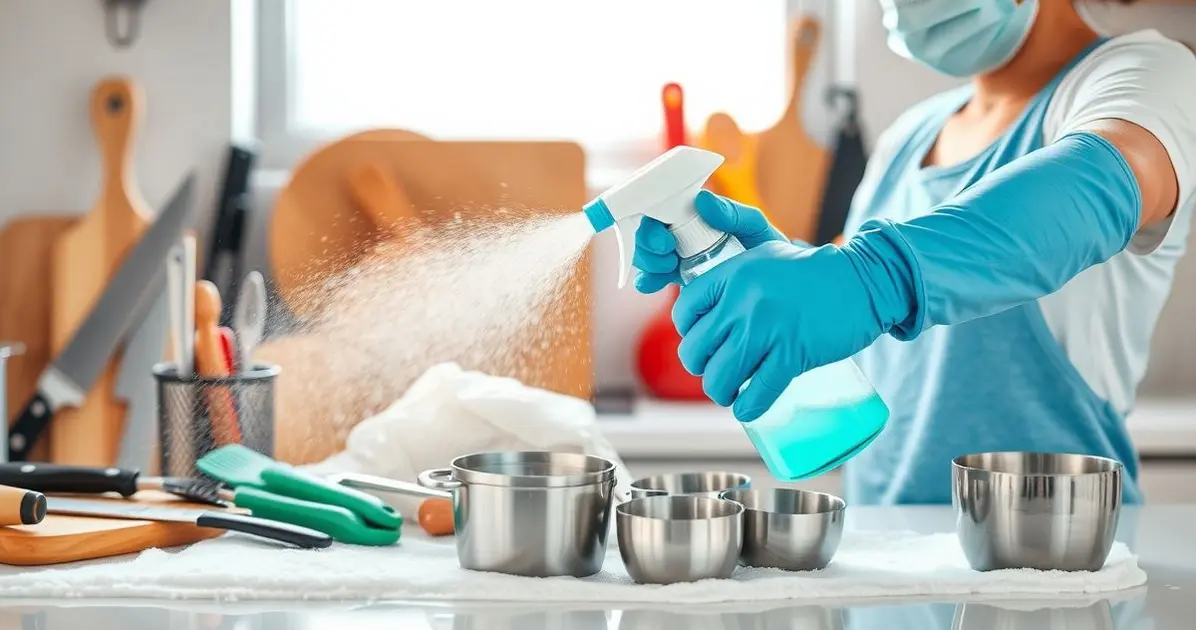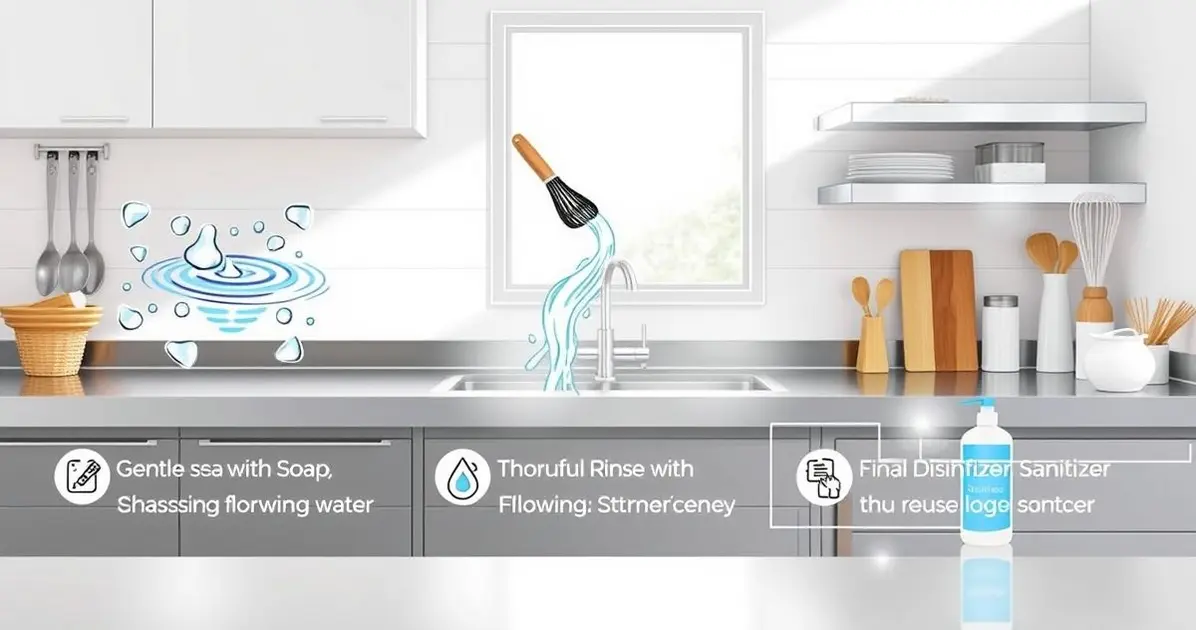Sanitizing tools and equipment in the kitchen is crucial to prevent foodborne illnesses. This involves proper cleaning techniques and using effective sanitizers to ensure your cooking environment is safe.
How to sanitize tools and equipment in cooking

To keep your kitchen safe, it’s essential to sanitize your cooking tools and equipment regularly. The process includes washing with hot, soapy water, rinsing, and applying a suitable sanitizer. This practice helps eliminate harmful bacteria and maintains food safety.
Understanding the Difference Between Cleaning and Sanitizing
Understanding the difference between cleaning and sanitizing is essential for maintaining a safe and hygienic kitchen. While both processes are important, they serve different purposes in food safety:
1. Cleaning: Cleaning is the physical process of removing dirt, food particles, and grease from surfaces and tools. This is typically done using soap and water. Key points about cleaning include:
- Physical Removal: Cleaning involves scrubbing surfaces to remove visible debris and stains.
- Frequency: Cleaning should be done regularly, especially after preparing food, to prevent the buildup of dirt and bacteria.
- Tools Used: Common cleaning tools include sponges, brushes, and cloths, along with cleaning agents like dish soap.
2. Sanitizing: Sanitizing goes a step further by reducing the number of germs on surfaces to safe levels. This process does not necessarily remove dirt but focuses on killing bacteria and viruses. Important aspects of sanitizing include:
- Reduction of Germs: Sanitizing reduces the number of harmful microorganisms to a level that is considered safe for health.
- Methods: Common sanitizing methods include using chemical solutions (like bleach or commercial sanitizers) or heat (such as boiling water).
- Post-Cleaning Step: Sanitizing is usually performed after cleaning, as it is most effective on clean surfaces.
3. When to Use Each Process:
- Before Cooking: Always clean surfaces and tools before cooking to remove dirt and food residues.
- After Handling Raw Foods: After preparing raw meats or poultry, clean and then sanitize surfaces and utensils to prevent cross-contamination.
- Regular Maintenance: Incorporate both cleaning and sanitizing into your regular kitchen maintenance routine to ensure a safe cooking environment.
In summary, while cleaning and sanitizing are both critical for maintaining a hygienic kitchen, they serve different functions. Cleaning removes dirt and food residues, while sanitizing reduces harmful microorganisms to safe levels. Understanding and implementing both processes will help ensure food safety and promote a healthier cooking environment!
Recommended Sanitizing Solutions for Kitchen Tools
Using the right sanitizing solutions is crucial for maintaining a safe and hygienic kitchen. Here are some recommended sanitizing solutions for kitchen tools:
1. Chlorine Bleach Solution: One of the most effective and widely used sanitizing solutions is a diluted chlorine bleach solution:
- Preparation: Mix one tablespoon of unscented bleach with one gallon of water.
- Application: Soak kitchen tools, such as cutting boards and utensils, in the solution for at least 5 minutes to effectively kill bacteria.
- Rinsing: After sanitizing, rinse the tools thoroughly with clean water to remove any bleach residue.
2. White Vinegar: White vinegar is a natural disinfectant that can be used for sanitizing surfaces and utensils:
- Application: Use undiluted white vinegar to spray on surfaces or soak utensils for 10-15 minutes.
- Effectiveness: Vinegar is effective against some bacteria and can help neutralize odors.
3. Hydrogen Peroxide: Hydrogen peroxide is another effective sanitizing agent:
- Preparation: Use a 3% hydrogen peroxide solution for sanitizing.
- Application: Spray or soak kitchen tools and surfaces, allowing them to sit for a few minutes before rinsing.
4. Commercial Food-Safe Sanitizers: There are various commercial sanitizers available that are specifically designed for kitchen use:
- Read Labels: Always choose food-safe sanitizers and follow the manufacturer’s instructions for proper dilution and application.
- Effectiveness: These products are formulated to kill a wide range of bacteria, ensuring a safe cooking environment.
5. Vinegar and Baking Soda Combination: For a natural cleaning and sanitizing solution, combine vinegar and baking soda:
- Preparation: Sprinkle baking soda on surfaces, then spray with vinegar. This combination creates a fizzing reaction that helps lift grime.
- Application: After the fizzing subsides, scrub the area and rinse thoroughly.
6. Hot Water: Using hot water is an effective method for sanitizing:
- Boiling Water: Boil water and pour it over utensils and surfaces to kill bacteria. Ensure the items can withstand high temperatures.
- Dishwasher: If your kitchen tools are dishwasher safe, running them through a hot cycle can also effectively sanitize them.
By utilizing these recommended sanitizing solutions, you can ensure that your kitchen tools and equipment remain safe and hygienic. Regular sanitization is key to preventing foodborne illnesses and maintaining a clean cooking environment!

Best Practices for Maintaining a Safe Cooking Environment
Maintaining a safe cooking environment is essential for preventing foodborne illnesses and ensuring the well-being of everyone in the kitchen. Here are some best practices for maintaining a safe cooking environment:
1. Practice Proper Hygiene: Ensure that everyone in the kitchen follows strict hygiene practices:
- Handwashing: Wash hands thoroughly with soap and warm water before and after handling food, especially raw meats and poultry.
- Clean Clothing: Wear clean aprons and avoid loose clothing that could catch fire or get caught in equipment.
2. Keep Surfaces Clean: Regularly clean and sanitize all kitchen surfaces:
- Countertops: Wipe down countertops before and after food preparation to remove any contaminants.
- Cutting Boards: Use separate cutting boards for raw meats and vegetables to prevent cross-contamination.
3. Use Safe Food Handling Practices: Follow safe food handling practices to reduce the risk of contamination:
- Store Food Properly: Keep raw meats on the bottom shelf of the refrigerator to prevent juices from dripping onto other foods.
- Thawing: Thaw frozen foods in the refrigerator, in cold water, or in the microwave, but never at room temperature.
4. Maintain Equipment: Regularly check and maintain kitchen tools and appliances:
- Inspect for Damage: Regularly inspect your tools for signs of wear and tear, and replace any damaged items immediately.
- Clean Appliances: Keep appliances clean and in good working order to prevent accidents and ensure efficient operation.
5. Properly Store Cleaning Supplies: Store cleaning agents and chemicals safely:
- Out of Reach: Keep cleaning supplies out of reach of children and clearly label all containers.
- Designated Area: Store cleaning supplies in a separate area away from food items to prevent contamination.
6. Educate Kitchen Staff: Ensure that everyone using the kitchen understands food safety protocols:
- Training: Provide training on safe food handling, cleaning procedures, and the importance of hygiene.
- Regular Meetings: Hold regular meetings to discuss food safety practices and address any concerns.
7. Be Aware of Allergens: Take precautions to prevent cross-contact with allergens:
- Labeling: Clearly label all food items and ingredients that may contain common allergens.
- Separate Preparation Areas: Use separate preparation areas and utensils for allergen-free foods.
By following these best practices for maintaining a safe cooking environment, you can create a kitchen that promotes health and safety while enhancing the overall cooking experience. A commitment to cleanliness and safety is essential for every cook, whether at home or in a professional setting!
Techniques for Sanitizing Knives, Cutting Boards, and Utensils
Sanitizing knives, cutting boards, and utensils is a critical step in maintaining a safe cooking environment. Here are some effective techniques for sanitizing these essential kitchen tools:
1. Sanitizing Knives:
- Wash Immediately: After using knives, wash them with warm, soapy water to remove food residues. Avoid soaking them for extended periods.
- Use a Sanitizing Solution: Prepare a sanitizing solution by mixing one tablespoon of unscented bleach with one gallon of water. Soak the knives in this solution for a few minutes to kill any bacteria.
- Rinse and Dry: After sanitizing, rinse the knives thoroughly with clean water to remove any bleach residue. Dry them immediately with a clean towel to prevent rust.
2. Sanitizing Cutting Boards:
- Clean Before Sanitizing: Wash cutting boards with warm, soapy water to remove food particles. Use a scrub brush for plastic boards and a damp cloth for wooden boards.
- Disinfecting Solution: For plastic cutting boards, use the same bleach solution as for knives. For wooden boards, a mixture of vinegar and water can be effective.
- Allow to Air Dry: After sanitizing, let cutting boards air dry completely to prevent moisture buildup, which can lead to bacteria growth.
3. Sanitizing Utensils:
- Wash Thoroughly: Clean utensils with warm, soapy water immediately after use. Pay special attention to areas that may retain food particles.
- Soak in Sanitizing Solution: Soak utensils in the sanitizing solution for several minutes. Ensure that all surfaces are submerged for effective sanitization.
- Rinse and Dry: After sanitizing, rinse utensils thoroughly with clean water to remove any residual sanitizing solution. Dry them with a clean towel or let them air dry.
4. General Tips for Sanitizing:
- Frequency: Sanitize knives, cutting boards, and utensils regularly, especially after preparing raw meats or poultry.
- Use Separate Tools: Designate specific knives and cutting boards for raw and cooked foods to minimize cross-contamination.
- Educate Others: Ensure that everyone using the kitchen understands the importance of sanitizing tools and follows proper procedures.
By employing these techniques for sanitizing knives, cutting boards, and utensils, you can significantly reduce the risk of foodborne illnesses and maintain a safe cooking environment. Regular sanitization is key to ensuring your kitchen tools remain hygienic and effective for all your cooking needs!
Conclusion
In conclusion, maintaining a safe and hygienic kitchen is essential for both food safety and culinary success. By implementing effective sanitization techniques for knives, cutting boards, and utensils, you can significantly reduce the risk of foodborne illnesses and ensure that your kitchen tools remain in optimal condition.
Understanding the importance of proper cleaning and sanitizing methods, along with using the right solutions, is crucial in fostering a clean cooking environment. Regularly sanitizing your kitchen tools not only enhances food safety but also contributes to a more enjoyable cooking experience.
By following the tips and techniques outlined in this guide, whether you are a home cook or a professional chef, you can elevate your culinary practices and create a kitchen that is both safe and efficient. Embrace these practices to ensure that your kitchen remains a healthy space for all your cooking endeavors!
FAQ – Frequently Asked Questions about Sanitizing Kitchen Tools
Bakit mahalaga ang sanitizing ng mga kagamitan sa pagluluto?
Mahalaga ang sanitizing upang maiwasan ang foodborne illnesses at matiyak na ang mga kagamitan ay ligtas gamitin sa paghahanda ng pagkain.
Ano ang pagkakaiba ng cleaning at sanitizing?
Ang cleaning ay ang proseso ng pagtanggal ng dumi at residue, habang ang sanitizing ay ang pagbawas ng mga harmful microorganisms sa ligtas na antas.
Anong mga solusyon ang maaaring gamitin para sa sanitizing?
Maaari kang gumamit ng diluted bleach solution, white vinegar, hydrogen peroxide, o commercial food-safe sanitizers.
Paano dapat i-sanitize ang mga kutsilyo?
Hugasan ang mga kutsilyo gamit ang mainit na tubig at sabon, pagkatapos ay soak sa sanitizing solution at banlawan ng mabuti bago tuyuin.
Gaano kadalas dapat i-sanitize ang mga cutting boards at utensils?
Dapat i-sanitize ang mga cutting boards at utensils pagkatapos gamitin, lalo na pagkatapos humawak ng raw meat.
Ano ang mga best practices para sa pagpapanatili ng ligtas na kapaligiran sa kusina?
Magsagawa ng regular na paglilinis at sanitizing, gumamit ng mga hiwalay na kagamitan para sa raw at lutong pagkain, at sanayin ang lahat ng gumagamit ng kusina sa tamang mga pamamaraan.
See more
Discover plenty of easy and delicious recipes you can make at home, from hearty dinners to indulgent desserts and wholesome breakfasts.




